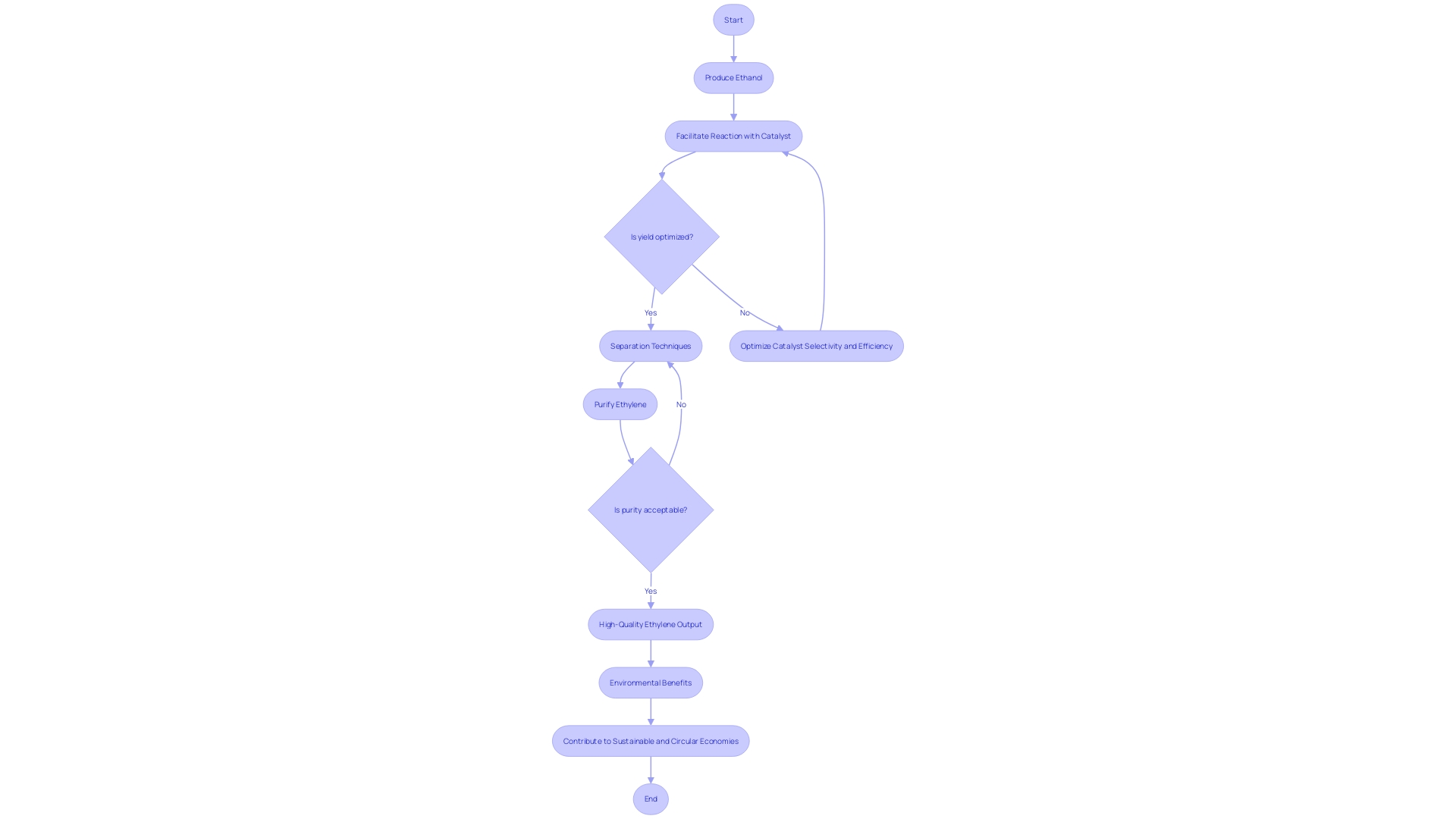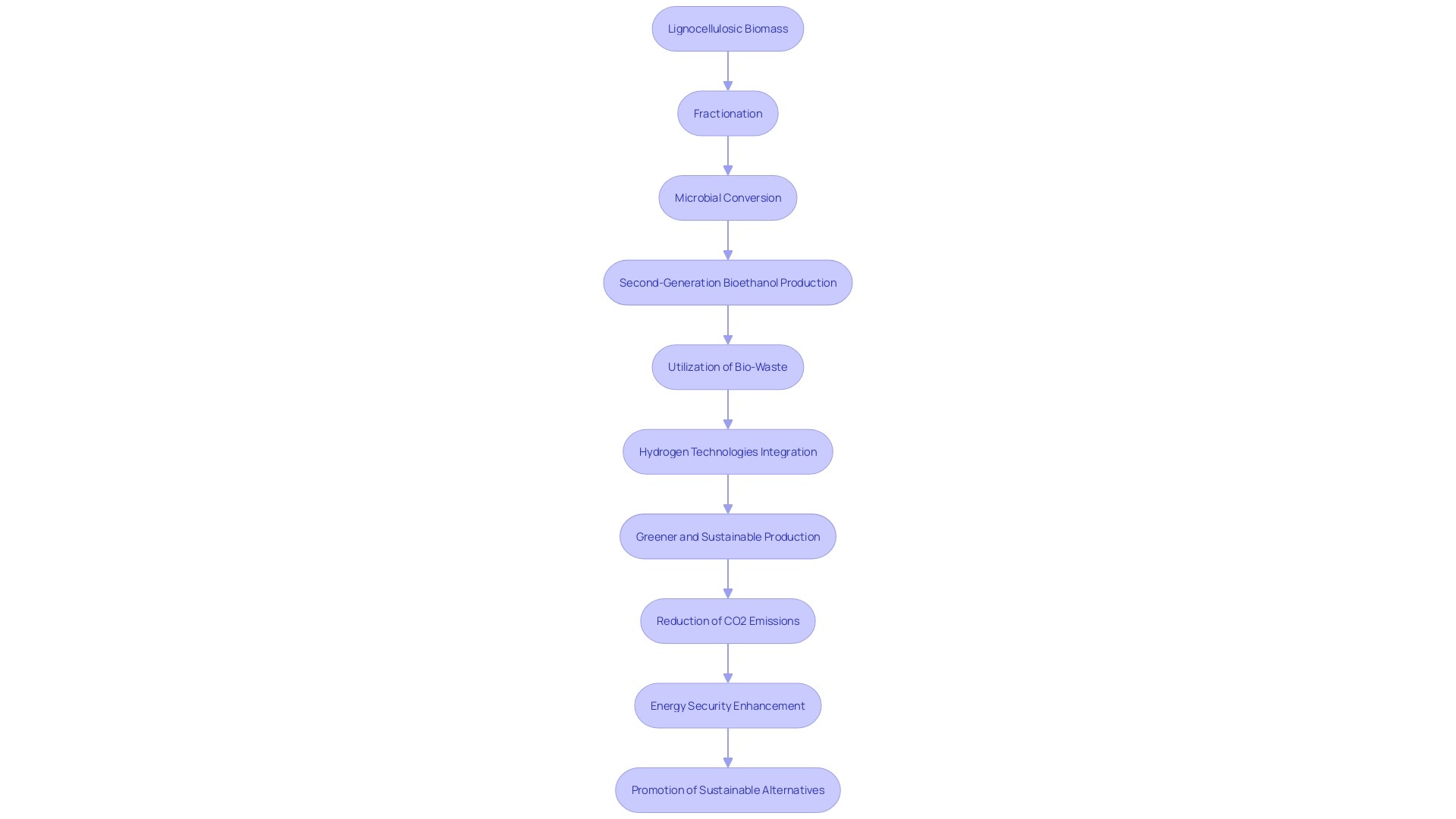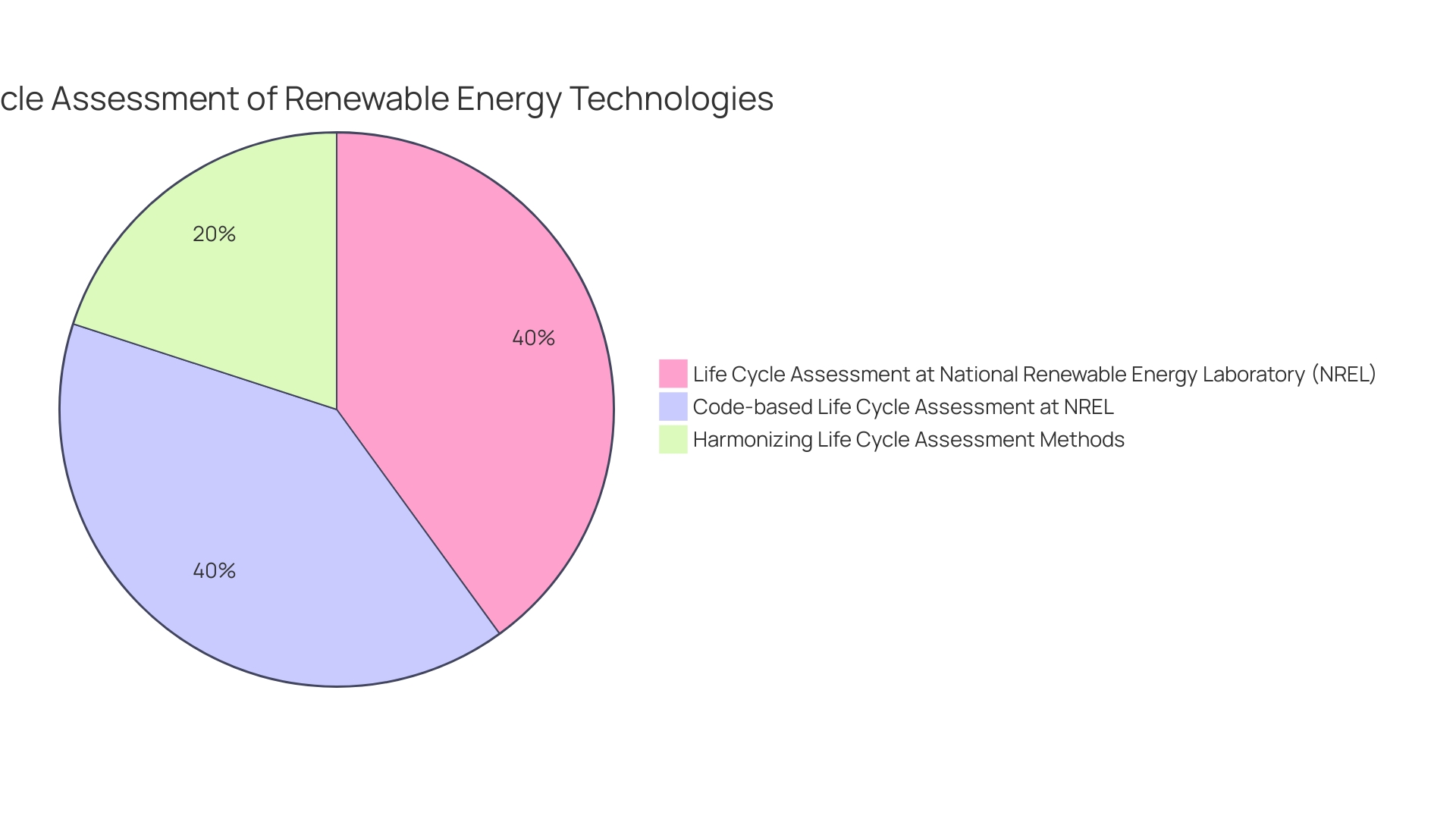Introduction
Ethylene, a key component in various products, has long been produced through carbon-intensive methods, contributing to the climate crisis. However, the renewable fuels industry is now exploring bio-based ethylene production as a sustainable alternative. Driven by a global commitment to decarbonization, this innovation aims to eliminate the use of fossil fuels and significantly reduce CO2 emissions.
Advancements in oxidative coupling of methane (OCM) and the use of carbon dioxide as a feedstock offer greener alternatives that align with renewable energy sources. As the petrochemical industry strives for cleaner production cycles and sustainable sourcing, these innovations in ethylene production are both promising and necessary. This article delves into the technical insights and analysis of the renewable fuels industry, providing a deep understanding of the challenges, opportunities, and future prospects in bioethylene production.
Background: Traditional vs. Bio-Based Ethylene Production
Ethylene stands as the cornerstone of the petrochemical industry, ubiquitous in products ranging from antifreeze to food packaging, and from electronics to building materials. Despite its widespread use, the traditional production of ethylene is a carbon-intensive process. It is not merely the consumption of fossil fuels like natural gas that raises environmental concerns; it is also the significant release of greenhouse gases during production. For every ton of ethylene produced, approximately one to two tonnes of carbon dioxide are released, contributing to the escalating climate crisis.
In contrast, bio-based ethylene production is emerging as a sustainable alternative, utilizing microbial conversion of organic substrates. This method not only circumvents the use of fossil fuels as raw materials but also promises to significantly reduce CO2 emissions. The innovation in this field is exemplified by the work of Dr. Christine Gabardo, who with her team, is scaling up a groundbreaking process that could revolutionize ethylene production by eliminating fossil fuels from the equation.
Recent advancements in the oxidative coupling of methane (OCM) offer a greener alternative to the energy-intensive steam cracking method, potentially transforming the way ethylene is produced. Moreover, the intriguing possibility of using carbon dioxide itself as a feedstock for ethylene, in combination with hydrogen obtained from renewable sources, is being explored. Although this concept requires the ability to operate under fluctuating conditions — a new challenge for chemical processes — it aligns with the goal of using renewable energies like solar and wind power.
As the petrochemical industry looks to align with global decarbonization efforts, these innovations in ethylene production are not just promising but necessary. They represent a shift towards cleaner production cycles and the sustainable sourcing of materials — key factors in mitigating the impact of industry on our planet.
The Process of Ethanol Dehydration to Ethylene
The transition from fossil fuel-based ethylene to bio-based ethylene production is gaining momentum, particularly through the process of ethanol dehydration. This process involves a series of complex reactions facilitated by catalysts under specific conditions to convert ethanol into ethylene. At the forefront of this conversion is the catalyst's selectivity and efficiency, which are critical for optimizing the yield and purity of the ethylene produced.
In the dehydration of ethanol, the reaction conditions are finely tuned to achieve the maximum conversion rate. The presence of a catalyst is indispensable for guiding the reaction pathway towards ethylene formation while minimizing side reactions. Advances in catalyst development are continuously being made, with the goal of enhancing the selectivity towards ethylene and improving the overall efficiency of the process.
Separation techniques play a pivotal role following the reaction, ensuring that the resulting ethylene is of high purity, suitable for subsequent applications. As ethylene serves as a foundational block for numerous products including antifreeze, food packaging, and textiles, the quality of the output is of utmost importance.
Ethylene's wide application in various industries, combined with the environmental benefits of bio-based production methods, underscores the significance of refining ethanol conversion processes. Such advancements not only contribute to reducing greenhouse gas emissions but also pave the way for creating more sustainable and circular economies, particularly in the context of upcycling waste materials.
The bio-based production of ethylene presents a novel approach to mitigate the climate crisis by offering a sustainable alternative to the conventional petrochemical processes. This innovation aligns with the global efforts to decrease carbon footprint and foster the development of eco-friendly industrial practices.

Techno-Economic Analysis of Bioethylene Production
A techno-economic analysis (TEA) is a pivotal step in assessing the feasibility of bioethylene production, delving deep into the economics of the process, backed by detailed process flow diagrams and mass and energy balances. The objective is to meticulously calculate the capital and operational costs associated with bioethylene production. Such an analysis not only scrutinizes the initial investment and ongoing expenses but also evaluates market demand to ensure economic viability.
In the context of bioethylene, which is at the forefront of a global market worth trillions, the selection of catalysts and the optimization of process parameters are crucial for cost-effectiveness and sustainability. With the petrochemical industry's reliance on outdated technologies, the shift towards using CO2, a notorious climate change contributor, as a raw material in the lab for producing valuable chemicals like lower olefins, presents a revolutionary opportunity.
The challenge lies in ensuring that these processes can run under fluctuating conditions, a necessity when relying on renewable energy sources like solar and wind. This is especially pertinent when considering the oxidative coupling of methane (OCM) as an alternative to the traditional steam cracking method for ethylene production, which is notorious for its high energy consumption and carbon footprint.
Producing ethylene, a fundamental component in an array of products such as antifreeze, vinyl, and plastics, through greener methods could significantly reduce the petrochemical industry's environmental impact. The modernization of financial record-keeping and the surge of data in the Information Age serve as a backdrop for TEA, enabling more accurate and effective resource allocation to support such sustainable initiatives.

Impact of Ethanol Quality on Bioethylene Production
The efficacy of ethanol as a feedstock in bioethylene production is significantly influenced by its purity. Specifically, the presence of impurities, the level of water content, and the overall composition of the ethanol are critical factors that can affect the conversion efficiency and the quality of the ethylene produced. Ethanol derived from sugarcane, as highlighted by the Brazilian guidelines (MAPA), emphasizes the need for a feedstock that is made exclusively from fermented sugarcane juice. This approach not only aligns with public health standards but also ensures the integrity of the resultant bio-based product.
The production of cachaça, a traditional Brazilian spirit, provides an interesting parallel to the importance of feedstock purity in bioethylene production. The historical context of cachaça, which dates back to the introduction of sugarcane in Brazil during the Portuguese settlement, showcases the evolution of a product that maintains high standards of purity and quality through strict guidelines, similar to the Decree 4062/2001 for cachaça. Such regulatory frameworks are instrumental in preserving product integrity.
Furthermore, the innovation in the brewing industry, as seen in the collaboration between Fertiberia and Heineken Spain, exemplifies the shift toward green hydrogen to minimize carbon footprint in production processes. This initiative mirrors the trend in bioethylene production to adopt sustainable and low-carbon practices. By ensuring high-purity ethanol feedstock, producers can achieve an 'Impact Zero' manufacturing process, aligning with the broader goal of reducing CO2e emissions and moving toward net-zero targets.
These instances underscore the importance of adhering to quality guidelines and the adoption of advanced technologies to improve product integrity and sustainability. With a focus on high-purity ethanol, bio ethylene producers can ensure optimal yields and contribute to a more sustainable future.
Industrial Applications and Existing Plants
Within the industrial sector, bioethylene stands as a cornerstone, paving the way for advancements in manufacturing and packaging. The substance's versatility sees it integrated across a broad spectrum of applications, prominently including plastics and packaging materials. A survey of current global bioethylene production facilities reveals a diverse array of uses that permeate multiple industries. This diversity is a testament to the burgeoning market demand for bioethylene, affirming its potential to further permeate various sectors.
Evonik Industries AG, a leader in specialty chemicals, exemplifies the dynamic application of bio-based products like bioethylene in its Nutrition & Care division. The division, which produced sales of €4.24 billion in 2022, actively develops solutions across a broad range of resilient end markets, including pharmaceuticals, medical devices, and personal care. The versatility of bioethylene is also mirrored in the steel industry, where companies such as ArcelorMittal are pioneering the use of innovative processes that utilize less energy and reduce carbon emissions. Primetals Technologies and E4tech are at the forefront as well, contributing to the sustainable transformation of the energy and metals sectors.
The transformative potential of bioethylene is underscored by research into carbon dioxide utilization. The DOI: 10.1016/j.jcat.2023.07.012 publication highlights the innovative use of CO2, a significant climate change contributor, as a raw material in the sustainable production of lower olefins and other valuable chemicals. The importance of adapting to 'fluctuating' conditions in chemical processes is emphasized, ensuring compatibility with the variable supply of renewable energy sources, such as solar and wind power. This adaptability is crucial for the future scalability of bioethylene production.
Furthermore, the European biofuel market, with its focus on ethanol, biodiesel, and renewable diesel, is supported by policies that encourage the adoption of bio-based alternatives, contributing to the region's energy transformation. The EU's proactive initiatives serve to catalyze the growth of bio-based markets, including that of bioethylene, highlighting the region's commitment to sustainable development.
In conclusion, bioethylene's expanding influence across industries is not only a reflection of current market demand but also an indicator of its future potential. As industries increasingly seek sustainable alternatives, bioethylene's role is poised to grow, driven by innovation and a global commitment to reducing carbon footprints.
Challenges and Opportunities in 2nd Generation Bioethanol
As the renewable energy sector matures, second-generation bioethanol production, utilizing non-food biomass such as agricultural residues, forest biomass, and energy crops, emerges as a pivotal innovation in the biofuels industry. This technological leap addresses the ethical concerns surrounding first-generation biofuels, which often compete with food resources, by shifting the focus to lignocellulosic biomass that doesn't interfere with food supply chains.
Significant strides have been made in the field of industrial biotechnology, particularly in the development of Co-solvent Enhanced Lignocellulosic Fractionation (CELF) biorefineries. These cutting-edge facilities perform an initial fractionation of the biomass, enabling the concurrent production of multiple products from each primary biomass component. Such advancements are instrumental in addressing the pressing need for decarbonization across multiple sectors, from fuels to chemicals, and in reducing our reliance on fossil-based carbon materials—currently representing 47% of annual production.
The quest for optimal feedstocks for bioethanol conversion has led researchers to consider various types of biomass, with an emphasis on those that do not detract from food production. Poplar trees, for instance, have been identified as an ideal feedstock for CELF biorefineries due to their non-edible nature and high cellulose content.
Furthermore, the integration of microbial conversion processes in the production of biofuels and valuable chemicals presents a sustainable alternative to fossil feedstocks, promising significant energy savings and a reduction in CO2 emissions. This is corroborated by findings from a collaborative research effort between the University of California, Riverside, the Center for Bioenergy Innovation, and the National Renewable Energy Laboratory, funded by the U.S. Department of Energy's Office of Science.
Despite the progress, challenges persist, particularly in the efficient utilization of lignin, a major byproduct of lignocellulosic biomass fractionation. The industry continues to explore methods for converting lignin into bioethylene—a key component in the production of bioplastics and other materials. The innovative use of combined bio-waste and hydrogen technologies further exemplifies the industry's commitment to maximizing energy efficiency and transitioning to greener production methods.
These developments are not only advancing the biofuels sector but are also contributing to a more sustainable and environmentally-conscious chemical industry, opening doors to a new era of bioethylene production that aligns with the global objective of a green transition.

Life Cycle Assessment and Environmental Impacts
The life cycle assessment (LCA) of bio ethylene production is a meticulous process that evaluates the environmental repercussions across its entire life span. With a focus on sustainability, this analysis scrutinizes the generation of greenhouse gases, energy utilization, and the consumption of resources. Bioethylene emerges as a sustainable alternative when measured against traditional ethylene, which is primarily derived from fossil fuels. A significant aspect of this assessment is the extraction of raw materials for packaging, a process that can heavily influence the environmental impact of a product. For instance, the production of PET bottles alone accounts for nearly 84% of their environmental detriment, highlighting the importance of recycling and employing recycled materials.
During the manufacturing phase, the design and processing of materials play a vital role. A study has revealed that different packaging materials emit varying levels of greenhouse gases due to their distinct manufacturing methodologies. The National Renewable Energy Laboratory (NREL) has pioneered in standardizing LCA methods and data. The researchers at NREL have dedicated years to evaluating the environmental impacts of renewable energy technologies, aiming to foster a world powered by sustainable energy options. They have developed a code-based LCA using an open-source Python library, streamlining the process and enhancing its accuracy.
Furthermore, advancements in chemical processes have allowed for the utilization of carbon dioxide, a notorious greenhouse gas, as a feedstock for producing lower olefins, alcohols, and fuels. This innovative approach necessitates adaptability to fluctuating energy supplies, a characteristic intrinsic to renewable energy sources like solar and wind power. The oxidative coupling of methane (OCM) is a promising method for producing ethylene with a reduced carbon footprint. Although OCM presently falls short in economic competitiveness compared to steam cracking, it holds the potential to become a more sustainable production route for ethylene, a ubiquitous chemical in the petrochemical industry, and a cornerstone for countless consumer products.

Case Study: Optimizing Bioethanol-to-Bioethylene Plants
Exploring the cutting-edge advancements in bioethanol-to-bioethylene conversion, recent studies have shed light on innovative optimization strategies that enhance both process efficiency and economic viability. A notable example of such innovation is the utilization of non-edible lignocellulosic biomass, such as that derived from poplar trees, which avoids the ethical and environmental issues associated with first-generation biofuels made from food crops. Advanced biorefineries now implement an upfront fractionation of this sustainable biomass, enabling the concurrent production of diverse bioproducts.
Catalyst selection and reaction conditions are among the critical parameters fine-tuned to maximize the yield and quality of bioethylene. For instance, technological progress in microbial fermentation, a cornerstone of biomanufacturing, has led to the development of robust steel bioreactors that facilitate the growth of microbes in high volumes under controlled conditions. These advancements have paved the way for the use of engineered strains of microbes such as Clostridium thermocellum that are capable of producing ethanol with high efficiency, although challenges such as ethanol tolerance remain to be addressed.
Separation techniques have also seen substantial improvements. The integration of innovative processes not only reduces energy consumption and carbon emissions but also lowers operational costs, contributing to the overall sustainability of the plant's operations. Companies like Primetals Technologies and E4tech are at the forefront of these advancements, offering engineering solutions and strategic consultancy to enhance the lifecycle of metals used in renewable energy infrastructure.
As the renewable fuels industry evolves, the shift towards second-generation biofuels that leverage cellulosic biomass has become increasingly important. With a focus on long-term sustainability and carbon neutrality, industry leaders are driving the transition to smarter, cleaner, and more efficient production methods. The success of these optimization strategies is evidenced by the growing adoption of bio-based products, signaling a promising future for the production of bioethylene and other renewable materials.

Economic Feasibility and Cost Analysis
A meticulous examination of the economic feasibility of bioethylene production entails an analysis of capital investment, operating costs, and potential revenue streams. The production of bio-based chemicals like indigo and indican has been explored with an emphasis on sustainability, considering the economic, environmental, and social impact. Innovative methods in industrial biotechnology, such as the engineering of a stabilized glycosyltransferase mutant for Indian production, highlight the potential for efficient processes with minimal environmental footprint and negligible social repercussions.
The urgency of this shift is underscored by the reality that two-thirds of anthropogenic CO2 emissions stem from the combustion of fossil fuels. With 47% of carbon-based materials annually produced from fossil sources, the need for cleaner production cycles is clear. The transition to bio-based alternatives is not just environmentally imperative but also economically strategic, as evidenced by the successful reduction of emissions in sectors regulated by the Emission Trading System (ETS) since 2005.
The economic analysis of bioethylene production begins with a comprehensive process flow diagram and mass and energy balance to detail each step of the production process. This process is critical as it lays the groundwork for the subsequent financial assessment, which involves a deep dive into capital and operating expenses. The history of financial record-keeping, which has seen significant advancements since the early 20th century, underlines the importance of meticulous economic evaluation for the effective allocation of resources.
As industries like steelmaking evolve to meet the demands of a changing world, adopting innovative processes that reduce energy consumption, carbon emissions, and costs become increasingly important. Companies like ArcelorMittal, a leader in steel production and mining, exemplify this transformation by producing cleaner, stronger, and reusable steels for electric vehicles and renewable energy infrastructure.
In light of these considerations, strategies to enhance the economic viability of bioethylene involve not only reducing production costs but also embracing innovative technologies that align with global sustainability goals. The future of bioethylene production is poised to be shaped by these economic and environmental imperatives, with the potential to contribute positively to both industry and the planet.

Future Prospects and Sustainability Benefits
The quest for sustainable alternatives to traditional petrochemical processes has led to significant interest in bioethylene production. Bioethylene, derived from renewable resources, has emerged as a promising candidate to supplant the energy-intensive steam cracking method currently used to produce ethylene. Steam cracking not only consumes large amounts of crude oil but also releases substantial carbon dioxide emissions, exacerbating the climate crisis.
Recent advancements in bioprocess technology have catalyzed the commercial viability of bioethylene, with oxidative coupling of methane (OCM) being one of the potential greener alternatives. Although previously hindered by low yields, ongoing research indicates promising improvements that could revolutionize the industry. In particular, Europe has been a pioneer in fostering biofuel market growth, with major economies such as France, UK, Germany, and Poland driving the expansion through robust policies and initiatives.
The sustainability benefits of bioethylene are manifold. Its production aligns with the global movement towards responsible innovation and the decarbonization of sectors dependent on fossil fuels. The transition to bio-based feedstocks for materials production is crucial in addressing environmental concerns, as highlighted by the pressing need to diminish the 47% of annual carbon-based materials production currently derived from fossil sources.
Moreover, the integration of bioethylene production into the wider bioprocess technology market can stimulate economic growth, particularly as pharmaceutical and biotechnology firms increase their demand for high-throughput and efficient bioprocessing systems. These systems are not only essential for regulatory compliance but also contribute to cost-efficiency and innovation.
Synthetic biology networks and foundations, such as SynBioBeta and the iGEM Foundation, underscore the importance of ethical, environmental, and security considerations in biotech advancements. They advocate for safety and security standards that protect the community and environment, ensuring that the development of bioethylene and other bio-based products is aligned with societal responsibility.
The future of bioethylene production is thus characterized by an interplay of technological innovation, market dynamics, and a steadfast commitment to sustainability. As bioethylene progresses towards scalability and commercialization, it offers a beacon of hope for a more sustainable and environmentally friendly petrochemical industry.
Conclusion
In conclusion, the renewable fuels industry is making significant progress in bio-based ethylene production, offering a sustainable alternative to carbon-intensive methods. Innovations like oxidative coupling of methane (OCM) and the use of carbon dioxide as a feedstock align with global decarbonization efforts and reduce CO2 emissions.
The transition to bio-based ethylene through ethanol dehydration and advancements in catalyst selectivity and separation techniques ensure high-quality output for various applications. Techno-economic analysis (TEA) plays a crucial role in assessing feasibility and optimizing cost-effectiveness.
High-purity ethanol feedstock is essential for optimal yields and a sustainable manufacturing process. Regulatory frameworks and advanced technologies preserve product integrity, while the integration of bioethylene across industries like plastics, packaging, and steel production highlights its versatility.
Second-generation bioethanol production utilizing non-food biomass and microbial conversion processes offers sustainable alternatives, reducing energy consumption and CO2 emissions. Life cycle assessment (LCA) confirms the environmental sustainability of bioethylene compared to traditional ethylene.
Optimization strategies in bioethanol-to-bioethylene plants focus on catalyst selection, reaction conditions, and separation techniques. The adoption of non-edible lignocellulosic biomass and microbial fermentation processes enhances efficiency and sustainability.
Economic feasibility and cost analysis are essential for the transition to bioethylene production, aligning with the goal of cleaner production cycles. The future prospects of bioethylene are promising, driven by ongoing research, bioprocess technology advancements, and supportive policies.
Bioethylene contributes to a greener and more sustainable petrochemical industry, aligning with responsible innovation and decarbonization efforts. The renewable fuels industry's progress in bio-based ethylene production offers a promising pathway to a more sustainable and environmentally friendly future.




